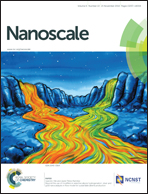Bimagnetic h-Co/h-CoO nanotetrapods: preparation, nanoscale characterization, three-dimensional architecture and their magnetic properties†
Abstract
Well-defined bimagnetic h-Co decorated wurtzite h-CoO nanotetrapods with uniform size have been successfully fabricated by a one-pot thermal decomposition method for the first time, and their three-dimensional architecture, crystal structure, chemical phase and exchange bias effect are characterized at the nanoscale. It is found that individual bimagnetic h-Co/h-CoO nanotetrapods are made of a h-CoO nanotetrapod skeleton to which multiple nanocrystals of ferromagnetic metallic h-Co are directly attached. The chemical analysis shows that the mass ratio of h-CoO and h-Co is 65 : 35. The detailed investigations of the crystal structure reveal that both the h-CoO nanotetrapod skeleton and h-Co nanoparticles have hexagonal structure. The four pods of individual nanotetrapods are single crystals with the same [001] orientation along with their pod axes and grow together by twinning with (110) the twin interface and the 120° spatial boundary angle. The magnetic measurements reveal that the h-Co/h-CoO nanotetrapods have a surprisingly strong room temperature ferromagnetism and there exists a weak exchange coupling between the h-CoO nanotetrapod skeleton and the decorated h-Co tiny nanoparticles. It is believed that our new structural form of the bimagnetic h-Co/h-CoO nanotetrapods provides not only a smart functional 3D nanoarchitecture as building block in nanoelectronics and nanosensors, but also an ideal specimen for a further understanding of weak antiferromagnetic-ferromagnetic interaction.



 Please wait while we load your content...
Please wait while we load your content...